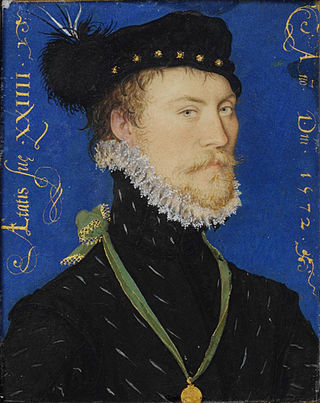
A portrait miniature is a miniature portrait painting, usually executed in gouache, watercolor, or enamel. Portrait miniatures developed out of the techniques of the miniatures in illuminated manuscripts, and were popular among 16th-century elites, mainly in England and France, and spread across the rest of Europe from the middle of the 18th century, remaining highly popular until the development of daguerreotypes and photography in the mid-19th century. They were usually intimate gifts given within the family, or by hopeful males in courtship, but some rulers, such as James I of England, gave large numbers as diplomatic or political gifts. They were especially likely to be painted when a family member was going to be absent for significant periods, whether a husband or son going to war or emigrating, or a daughter getting married.

Reza Abbasi, also known as Aqa Reza, was the leading Persian miniaturist of the Isfahan School during the later Safavid period, spending most of his career working for Shah Abbas I. He is considered to be the last great master of the Persian miniature, best known for his single miniatures for muraqqa or albums, especially single figures of beautiful youths.

Indian art consists of a variety of art forms, including painting, sculpture, pottery, and textile arts such as woven silk. Geographically, it spans the entire Indian subcontinent, including what is now India, Pakistan, Bangladesh, Sri Lanka, Nepal, and at times eastern Afghanistan. A strong sense of design is characteristic of Indian art and can be observed in its modern and traditional forms.

Mughal painting is a style of painting on paper confined to miniatures either as book illustrations or as single works to be kept in albums (muraqqa), from the territory of the Mughal Empire in South Asia. It emerged from Persian miniature painting and developed in the court of the Mughal Empire of the 16th to 18th centuries. Battles, legendary stories, hunting scenes, wildlife, royal life, mythology, as well as other subjects have all been frequently depicted in paintings.

Indian painting has a very long tradition and history in Indian art, though because of the climatic conditions very few early examples survive. The earliest Indian paintings were the rock paintings of prehistoric times, such as the petroglyphs found in places like the Bhimbetka rock shelters. Some of the Stone Age rock paintings found among the Bhimbetka rock shelters are approximately 10,000 years old.

A Persian miniature is a small Persian painting on paper, whether a book illustration or a separate work of art intended to be kept in an album of such works called a muraqqa. The techniques are broadly comparable to the Western Medieval and Byzantine traditions of miniatures in illuminated manuscripts. Although there is an equally well-established Persian tradition of wall-painting, the survival rate and state of preservation of miniatures is better, and miniatures are much the best-known form of Persian painting in the West, and many of the most important examples are in Western, or Turkish, museums. Miniature painting became a significant genre in Persian art in the 13th century, receiving Chinese influence after the Mongol conquests, and the highest point in the tradition was reached in the 15th and 16th centuries. The tradition continued, under some Western influence, after this, and has many modern exponents. The Persian miniature was the dominant influence on other Islamic miniature traditions, principally the Ottoman miniature in Turkey, and the Mughal miniature in the Indian sub-continent.
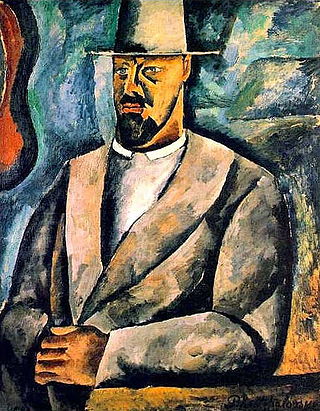
Pyotr Petrovich Konchalovsky was a Russian and Soviet painter, a member of the Knave of Diamonds group.
The Royal Society of Miniature Painters, Sculptors and Gravers, more commonly known as the Royal Miniature Society (RMS), is an art society founded in 1895 dedicated to upholding and continuing the tradition of miniature painting and sculpture, generally meaning the painted portrait miniature, a particular English tradition.
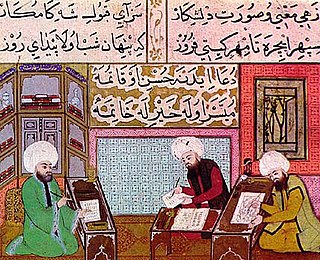
Ottoman miniature or Turkish miniature was a Turkish art form in the Ottoman Empire, which can be linked to the Persian miniature tradition, as well as strong Chinese artistic influences. It was a part of the Ottoman book arts, together with illumination, calligraphy, marbling paper, and bookbinding. The words taswir or nakish were used to define the art of miniature painting in Ottoman Turkish. The studios the artists worked in were called Nakkashanes.
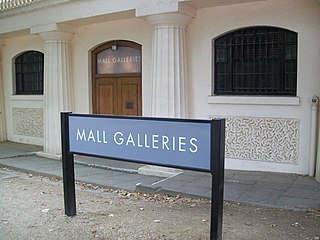
The Federation of British Artists (FBA) consists of nine art societies, and is based at Mall Galleries in London where the societies' Annual Exhibitions are held. The societies represent living artists working in the United Kingdom who create contemporary figurative art. Mall Galleries aim to 'promote, inspire and educate audiences about the visual arts.'
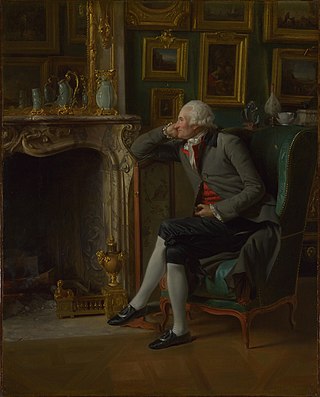
A cabinet painting is a small painting, typically no larger than two feet in either dimension, but often much smaller. The term is especially used for paintings that show full-length figures or landscapes at a small scale, rather than a head or other object painted nearly life-size. Such paintings are done very precisely, with a great degree of "finish". From the fifteenth century onward, wealthy collectors of art would keep these paintings in a cabinet, which was a relatively small and private room to which only those with whom they were on especially intimate terms would be admitted. A cabinet, also known as a closet, study, office, or by other names, might be used as an office or just a sitting room. Heating the main rooms in large palaces or mansions in the winter was difficult, so small rooms such as cabinets were more comfortable. They offered more privacy from servants or other household members and visitors. Typically, a cabinet would be for the use of a single individual; a large house might have at least two and often more.

'Abd al-Ṣamad or Khwaja 'Abd-us-Ṣamad was a 16th century painter of Persian miniatures who moved to India and became one of the founding masters of the Mughal miniature tradition, and later the holder of a number of senior administrative roles. 'Abd's career under the Mughals, from about 1550 to 1595, is relatively well documented, and a number of paintings are authorised to him from this period. From about 1572 he headed the imperial workshop of the Emperor Akbar and "it was under his guidance that Mughal style came to maturity". It has recently been contended by a leading specialist, Barbara Brend, that Samad is the same person as Mirza Ali, a Persian artist whose documented career seems to end at the same time as Abd al-Samad appears working for the Mughals.
Nakkaş Osman was the chief miniaturist for the Ottoman Empire during the later half of the sixteenth century. The dates of his birth and death are poorly known, but most of his works are dated to the last quarter of the sixteenth century.
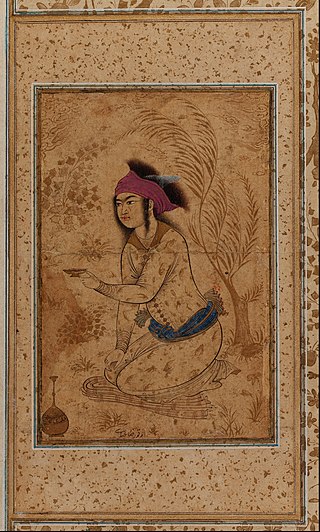
A Muraqqa is an album in book form containing Islamic miniature paintings and specimens of Islamic calligraphy, normally from several different sources, and perhaps other matter. The album was popular among collectors in the Islamic world, and by the later 16th century became the predominant format for miniature painting in the Persian Safavid, Mughal and Ottoman empires, greatly affecting the direction taken by the painting traditions of the Persian miniature, Ottoman miniature and Mughal miniature. The album largely replaced the full-scale illustrated manuscript of classics of Persian poetry, which had been the typical vehicle for the finest miniature painters up to that time. The great cost and delay of commissioning a top-quality example of such a work essentially restricted them to the ruler and a handful of other great figures, who usually had to maintain a whole workshop of calligraphers, artists and other craftsmen, with a librarian to manage the whole process.
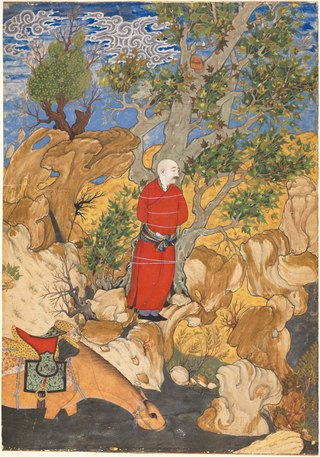
Sadiqi Beg, also referred to as Sadiqi Beg Afshar, was a painter, poet, biographer, draftsman, soldier and miniaturist of the Safavid period. He served as the head of the Royal Library serving under Shah Abbas I, and is most known for artistic reform.

Zinaida Yevgenyevna Serebriakova was a Russian and later French painter.

Prince Ibrahim Mirza, Solṭān Ebrāhīm Mīrzā, in full Abu'l Fat'h Sultan Ibrahim Mirza was a Persian prince of the Safavid dynasty, who was a favourite of his uncle and father-in-law Shah Tahmasp I, but who was executed by Tahmasp's successor, the Shah Ismail II. Ibrahim is now mainly remembered as a patron of the arts, especially the Persian miniature. Although most of his library and art collection was apparently destroyed by his wife after his murder, surviving works commissioned by him include the manuscript of the Haft Awrang of the poet Jami which is now in the Freer Gallery of Art in Washington D.C.

The Shahnameh of Shah Tahmasp or Houghton Shahnameh is one of the most famous illustrated manuscripts of the Shahnameh, the national epic of Greater Iran, and a high point in the art of the Persian miniature. It is probably the most fully illustrated manuscript of the text ever produced. When created, the manuscript contained 759 pages, 258 of which were miniatures. These miniatures were hand-painted by the artists of the royal workshop in Tabriz under rulers Shah Ismail I and Shah Tahmasp I. Upon its completion, the Shahnameh was gifted to Ottoman Sultan Selim II in 1568. The page size is about 48 x 32 cm, and the text written in Nastaʿlīq script of the highest quality. The manuscript was broken up in the 1970s and pages are now in a number of different collections around the world.

Anne Marjorie Robinson, sometimes Annie Marjorie Robinson, (1858–1924) was a British painter who also exhibited examples of her sculptures and miniatures.
May Bridges Lee (1884-1977), later Lady Stott, was an English portrait painter.




















